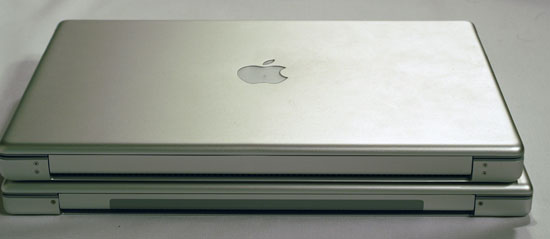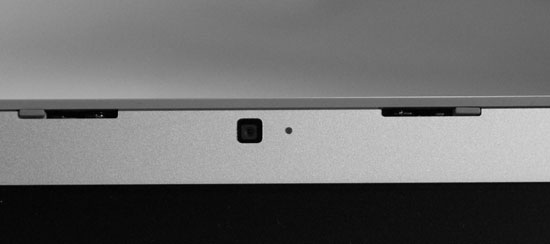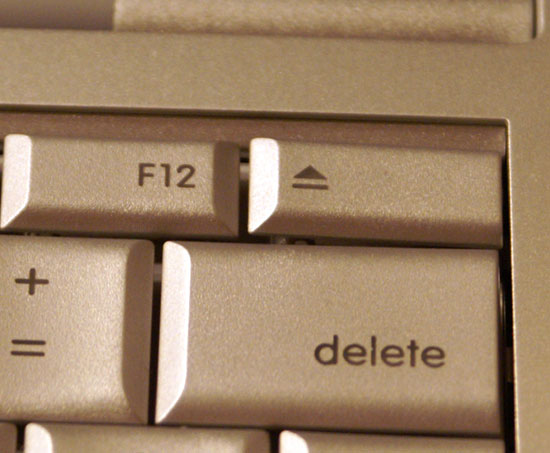Apple's MacBook Pro: Using it as a Mac and a PC
by Anand Lal Shimpi on April 13, 2006 12:00 AM EST- Posted in
- Mac
The MacBook Pro: So very similar, yet so very different
When Apple first announced that it had accelerated the introduction of the Intel based Macs and introduced the iMac Core Duo and MacBook Pro, I was not impressed. Maybe it was that my expectations were too high, but for Apple's first attempt at an Intel based Mac I expected a design that would blow me away. I expected the reaction to the Mac mini, but with even more punch, yet all I got were brand new internals in the same old exterior.

Compared to the G5, the new Core Duo processors were significantly less power hungry. As I showed in my iMac Core Duo review, you're looking at about 2/3 of the power consumption of the G5 yet the new CPUs were kept in the same chassis. For the MacBook Pro I expected something that was thinner than ever before, I expected Apple to virtually defy the laws of notebook making and truly deliver the most amazing thing I had ever seen running an Intel processor. Instead, Apple introduced something that looked very similar to my PowerBook G4 - but with a new power connector.
Part of the problem is that it took several weeks after the first announcement of the MacBook Pro for units to even be available to the public. At launch you couldn't go out and actually play with one of the new systems at an Apple store. I state this as a problem because after actually handling a MacBook Pro, the individually small improvements are pretty nice in the aggregate.
Compared to my 15" PowerBook G4 the 15" MacBook Pro is ever so slightly thinner; my PowerBook measured 1.1" in thickness and the new MacBook Pro is an even 1". Apple actually made the MacBook Pro slightly larger than its predecessor at 14.1" x 9.6" vs. 13.7" x 9.5" of the older PowerBook G4, but by making the unit slightly thinner and longer/wider the MacBook Pro actually ends up feeling a lot smaller than its predecessor. The slim theme continues even to Apple's packaging, as the MacBook Pro comes in a fairly thin (for a notebook) box. Much of the impact is psychological, but the MacBook Pro honestly does feel smaller than its predecessor despite being larger in two of its three dimensions. After putting the MacBook Pro in the same place on my desk that my PowerBook G4 used to sit, though, the MacBook Pro is definitely bigger.

PowerBook G4 (top) vs. MacBook Pro (bottom)

PowerBook G4 (top) vs. MacBook Pro (bottom)

PowerBook G4 (top) vs. MacBook Pro (bottom)
One of my first complaints about the PowerBook G4 was that the latch that kept the display lid closed felt like it would be the first thing to break. Thankfully it never has, but it never made me feel comfortable. On the MacBook Pro, Apple addressed the issue and replaced the single latch with a pair of latches. They are still controlled by the single button at the front of the unit but the end result is a more flush fitting display lid when closed and a much higher quality feel.

There's one latch on either side of the iSight camera
The construction overall appears to be better than the PowerBook G4, which held up fairly well while being in use for over a year. Unfortunately, the MacBook Pro does have a couple of assembly related issues, both of which are visible on the keyboard itself. A few of the keys squeak a lot when depressed, mainly the spacebar. More bothersome is the fact that two keys are poorly mounted. The eject button is by far the worst on the unit I'm reviewing as removing the key and replacing it doesn't actually put it back in line with the rest of the function keys. The only solution for this problem is to take it back to Apple.

The eject key looks like it's not set properly, but there's no fixing it. Apple quality control at its best.










52 Comments
View All Comments
Calin - Thursday, April 13, 2006 - link
This could be thanks to slower drivers in BootCamp Windows XP, or slower hard drive access/speed. Everything else is a disadvantage for VM: one more level of indirection in disk access, less memory, running the OS X behind the VM.Could you do some disk speed comparation between VM and native XP?
BigLan - Thursday, April 13, 2006 - link
I think it's going to be hard drive speed throwing off the benchmarks. The BootCamp partition is going to be at the outer edge of the disk, with much slower speeds than the VM client virtual drive which is on the faster Apple partition.I'm not sure if it's possible to assign the entire HD to a windows partition using Bootcamp, but that's about the only way i can think of to level the playing field.
Calin - Friday, April 14, 2006 - link
To nitpick, it would be at the center of the hard drive, not at the outer edge :) (ok, based on sector numbers, which starts at the edge).Near the "end" of the hard drive, the transfer speed is reduced (there are fewer bytes on a full circle).
jimmy43 - Thursday, April 13, 2006 - link
Excellent Review. This may be my first laptop purchase, seems to have everything I could possibly want.monsoon - Thursday, April 13, 2006 - link
Hello Anand,...i'm waiting for Parallels to finalize their VT release and maybe Merom Macs too...
I was wondering if the ONE CORE only VT tech is to be the final result of their virtualization software or just a middle-step.
Seems to me it's rather poor a solution ( ok, it's the best out there for now ) to use a dual-core computer to run both OS on a single core
=/
Better would be smart distribution of tasks to the CPU depending on which OS is actually under load...
...any thoughts / info on that ?
Thanks for your nice review !=)
plinden - Thursday, April 13, 2006 - link
Looking at CPU load while running Parallels VM, I see the load spread evenly over both processors (usually < 10% total CPU except at boot, when it reaches 150% CPU). It's just that the VM itself sees itself as running on a single processor.
shuttleboi - Thursday, April 13, 2006 - link
I've read that the ATI X1600 in the Mac can run games well, but only IF you overclock the GPU. I can't imagine the Mac getting any hotter than it already supposedly is, and the idea of overclocking an already hot laptop is not appealing.JoKeRr - Thursday, April 13, 2006 - link
Overall I enjoyed it.Would have been nice to see a comparison of screen brightness, as apple claimed 67% brighter!
And also, the slowness in windows, could it be related to chipset driver stuff?? And what's the gaming experience so far like?? Would it be similar to a desktop 6600 or 6600gt??
Thank you.
rolls - Friday, April 14, 2006 - link
Very interesting numbers all round.35% improvement in iTunes when comparing a single core 1.5GHz 7447 with the old slow bus etc, and a new 33% faster dual core intel CPU. 50% improvement in H.264 encoding etc. These numbers suggest that had Apple stuck with Freescale and moved to e600 core based systems, performance figures could have been off the scale. If only...
JarredWalton - Thursday, April 13, 2006 - link
On paper the X1600 Pro desktop cards actually look pretty decent. 12 pipelines at 500 MHz, with 800 MHz RAM. I would have thought they would at least give the 6600GT a run for the money, given how X1800 compares to 7800. Amazingly (to me), the X1600 gets completely stomped by the 6600GT. What's worse, the cards I have can't even overclock worth a darn on the memory side - 800 is stock, and they get unstable at even minor changes. (Could be an issue with the overclocking tool, though?)Anyway, for now I would say X1600 Mobility is going to be somewhere in the realm of 6600 (non-GT) performance, maybe slightly faster. That means gaming is definitely possible, but you will want low-to-medium detail levels for any recent titles. Just a guess, of course, and Anand will have to run benches to get any final confirmation. Really, though, this laptop isn't intended as anything more than a light gaming solution.